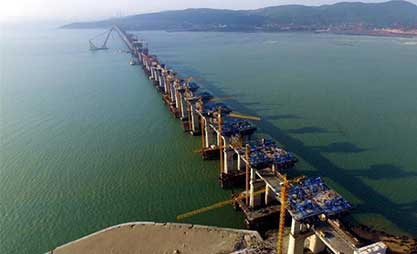

Air Quality
In 2016, Guangzhou witnessed substantial improvement in the quality of ambient air. The average density of PM2.5, PM10, nitrogen dioxide, sulfur dioxide and the 95th percentile density of carbon monoxide was 36 micrograms per cubic meter, 56 micrograms per cubic meter, 46 micrograms per cubic meter, 12 micrograms per cubic meter and 1.3 milligrams per cubic meter, down 7.7%, 5.1%, 2.1%, 7.7% and 7.1% year on year, respectively. The 90th percentile density of ozone was 155 micrograms per cubic meter, up 6.9% year on year. A total of 310 days reached the standard for air quality.
Sewage Prevention & Treatment
The overall water quality of local rivers remained stable in 2016. The water quality at 100% of the city’s centralized water source areas met the standard; the water quality at the crossovers of 100% of the rivers crossing through Guangzhou and other cities met the standard. The surface water with good quality at cross-sections reached 53.8% of the total during the provincial assessment (including national assessment).
Energy Conservation & Emission Reduction
In 2016, Guangzhou proposed 13 emission reduction tasks and 418 emission reduction projects, including 300 on water pollution and 118 on ambient air pollution, reaching the 2016 annual target of cutting the total emission of chemical oxygen demand, ammonia nitrogen, sulfur dioxide and nitrogen oxide by 3.5%, 3.5%, 2% and 2%, respectively.
Garbage Disposal
In 2016, Guangzhou promoted the sorting of life garbage steadily, with the number of communities adopting the model of “Fixed Hours and Fixed Spots” reaching 832 in total. The city also created 316 model corporations and institutions for garbage sorting as well as 1,247 qualified communities, primary and middle schools for life garbage sorting, of which the “Xicun Mode”, which introduced social capital in handling garbage sorting, was covered specially by a feature story of People’s Daily, a leading Chinese newspaper .
In 2016, the city cleaned and transferred a total of 5,043,500 tons of life garbage, with the innocent treatment rate of urban life garbage reaching 96.10%, up 0.86 percentage points year on year. The city’s overall recyclables reached 2.45 million tons.
Beautification & Afforestation
Guangzhou won the title of “National Model City for Afforestation” in 2016 and Haizhu Wetland was granted the China Habitat Environment Example Prize. In the same year, the city’s constructed areas had the afforestation rate of 36.4%, with the afforestation rate of 41.8% in total, the per capita park green space of 16.8 square meters and the forest coverage rate of 42.14%. The city had also built a total of 587 kilometers of landscape belts, further improving the natural and ecological forest corridor linking the city with the rural areas.
In the same year, the city beautified and afforested 574 villages, including 155 model villages, finishing the construction of 200 kilometers of greenway, creating and upgrading 24 refined greenways and bringing the city’s total mileage of greenway to 3,200 kilometers.
 Chinese brand becomes largest handset provider in Africa
Chinese brand becomes largest handset provider in Africa Busty Lais Ribeiro steals the Victoria's Secret Fashion Show
Busty Lais Ribeiro steals the Victoria's Secret Fashion Show Highlights Victoria's Secret Fashion Show in Shanghai
Highlights Victoria's Secret Fashion Show in Shanghai China's first cross-sea rail-road bridge takes shape
China's first cross-sea rail-road bridge takes shape A fancy world painted on fallen leaves
A fancy world painted on fallen leaves Photo album: Xi-Trump meeting in Beijing
Photo album: Xi-Trump meeting in Beijing Pitaya flower: blooms for one night, yields delicious fruit
Pitaya flower: blooms for one night, yields delicious fruit Hol Xil: Ideal habitat for Tibetan animals
Hol Xil: Ideal habitat for Tibetan animals Skywalk made of glass opens in Guizhou's Yuntaishan
Skywalk made of glass opens in Guizhou's Yuntaishan Top 10 most sustainable cities in China
Top 10 most sustainable cities in China Top 10 European patent applicants in 2016
Top 10 European patent applicants in 2016 The power of 'She' in China
The power of 'She' in China Seven most beautiful art museums in China
Seven most beautiful art museums in China Cyber rumors must be effectively addressed
Cyber rumors must be effectively addressed
 Migrant workers leave Beijing in droves amid evictions enacted following deadly fire
Migrant workers leave Beijing in droves amid evictions enacted following deadly fire
 Profits before pupils
Profits before pupils
 Is Weibo still the best choice for young Chinese when it comes to social media platforms?
Is Weibo still the best choice for young Chinese when it comes to social media platforms?
Day|Week